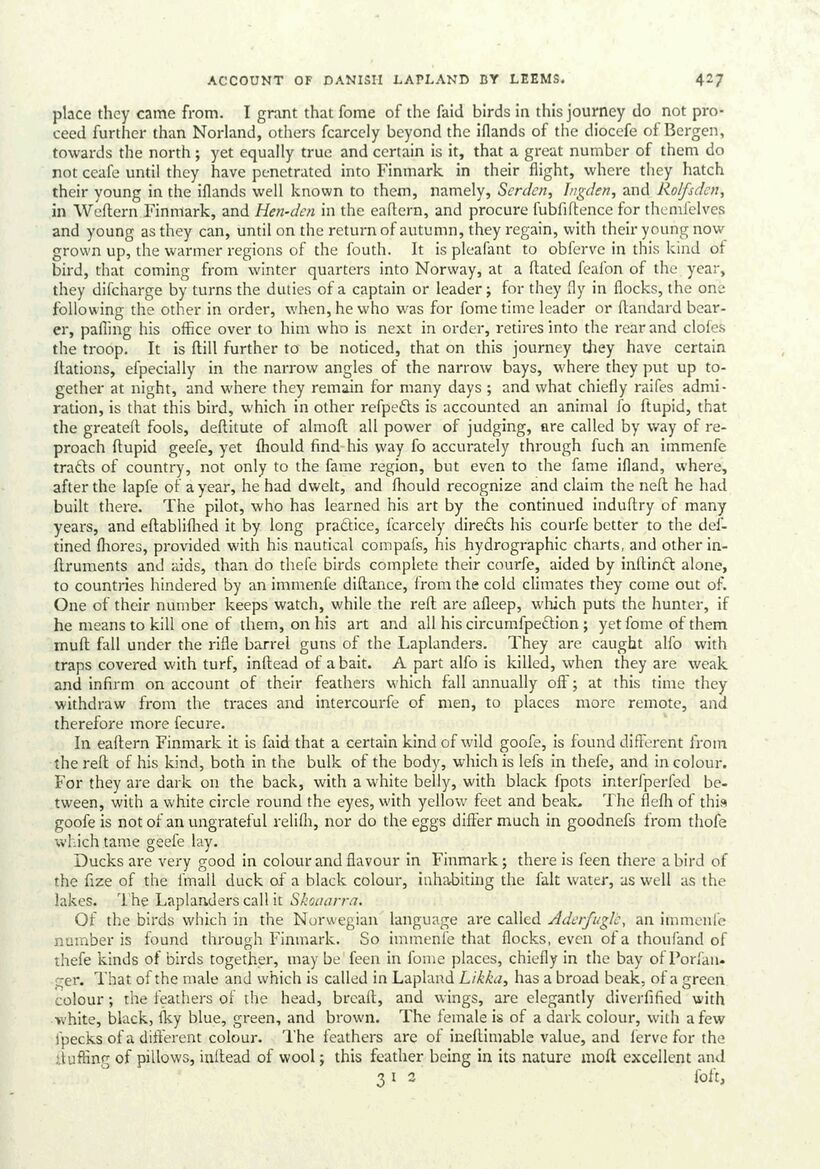
Full resolution (JPEG) - On this page / på denna sida - Pages ...

<< prev. page << föreg. sida << >> nästa sida >> next page >>
Below is the raw OCR text
from the above scanned image.
Do you see an error? Proofread the page now!
Här nedan syns maskintolkade texten från faksimilbilden ovan.
Ser du något fel? Korrekturläs sidan nu!
This page has never been proofread. / Denna sida har aldrig korrekturlästs.
ACCOUNT OF DANISH LAPLAND BY LEEMS. 427
place they came from. I grant that fome of the faid birds in this journey do not pro-
ceed further than Norland, others fcarcely beyond the iflands of the diocefe of Bergen,
towards the north; yet equally true and certain is it, that a great number of them do
not ceafe until they have penetrated into Finmark in their flight, where they hatch
their young in the iflands well known to them, namely, Serden, Ingden, and Rolfsden,
in Weftern Finmark, and Hen-den in the eaftern, and procure fubfiftence for themfelves
and young as they can, until on the return of autumn, they regain, with their young now
grown up, the warmer regions of the fouth. It is pleafant to obferve in this kind of
bird, that coming from winter quarters into Norway, at a {tated feafon of the year,
they difcharge by turns the duties of a captain or leader; for they fly in flocks, the one
following the other in order, when, he who was for fome time leader or ftandard bear-
er, pafling his office over to him who is next in order, retires into the rear and clofes
the troop. It is ftill further to be noticed, that on this journey they have certain
{tations, efpecially in the narrow angles of the narrow bays, where they put up to-
gether at night, and where they remain for many days; and what chiefly raifes admi-
ration, is that this bird, which in other refpeéts is accounted an animal fo ftupid, that
the greateft fools, deftitute of almoft all power of judging, are called by way of re-
proach ftupid geefe, yet fhould find-his way fo accurately through fuch an immenfe
tracts of country, not only to the fame region, but even to the fame ifland, where,
after the lapfe of a year, he had dwelt, and fhould recognize and claim the neft he had
built there. The pilot, who has learned his art by the continued induftry of many
years, and eftablifhed it by long practice, fcarcely direéts his courfe better to the def-
tined fhores, provided with his nautical compafs, his hydrographic charts, and other in-
{truments and aids, than do thefe birds complete their courfe, aided by infting& alone,
to countries hindered by an immentfe diftance, from the cold climates they come out of.
One of their number keeps watch, while the reft are afleep, which puts the hunter, if
he means to kill one of them, on his art and all his circum{pection ; yet fome of them
mutt fall under the rifle barrel guns of the Laplanders. They are caught alfo with
traps covered with turf, inftead of abait. A part alfo is killed, when they are weak
and infirm on account of their feathers which fall annually off; at this time they
withdraw from the traces and intercourfe of men, to places more remote, and
therefore more fecure. ;
In eaftern Finmark it is faid that a certain kind of wild goofe, is found different from
the reft of his kind, both in the bulk of the body, which is lefs in thefe, and in colour,
For they are dark on the back, with a white belly, with black fpots interfperfed be-
tween, with a white circle round the eyes, with yellow feet and beak. ‘The flefh of this
goofe is not of an ungrateful relifh, nor do the eggs differ much in goodnefs from thofe
which tame geefe lay.
Ducks are very good in colourand flavour in Finmark; there is feen there a bird of
the fize of the {mall duck of a black colour, inhabiting the falt water, as well as the
lakes. ‘Lhe Laplanders callit Skovarra.
Of the birds which in the Norwegian language are called Aderfugle, an immente
number is found through Finmark. So immente that flocks, even of a thoufand of
thefe kinds of birds together, may be’ feen in fome places, chiefly in the bay of Porfan.
ger. That of the male and which is called in Lapland Likka, has a broad beak, of a green
colour; the feathers of the head, breaft, and wings, are elegantly diverfified with
white, black, fky blue, green, and brown. ‘The female is of a dark colour, with afew
ipecks of a different colour. . The feathers are of ineftimable value, and ferve for the
itufling of pillows, inftead of wool; this feather being in its nature moft excellent and
31 2 foft,
<< prev. page << föreg. sida << >> nästa sida >> next page >>